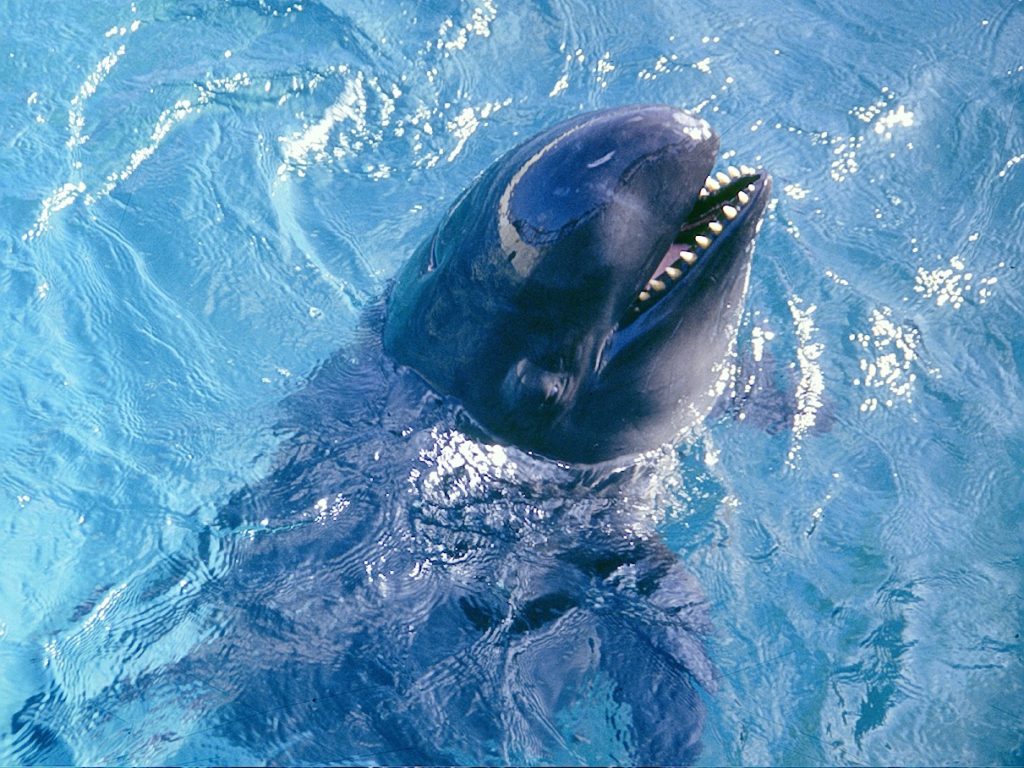False killer whale facts: discover a lesser-known relative of the bottlenose dolphin and killer whale.
False Killer Whale Facts at a Glance
- Scientific name: Pseudorca crassidens
- Type of Animal: Mammal
- Animal Family: Delphinidae (the oceanic dolphin family)
- Where Found: Tropical and semitropical oceans worldwide
- Average Length Male: up to 6 m (20 ft.); Female: Up to 5 m (16.4 ft.)
- Weight Male: up to 2,200 kg (4,900 lb.); Female: up to 1,200 kg (2,600 lb.)
- Conservation Status: Data Deficient
Other Interesting False Killer Whale Facts
- The false killer whale can reach speeds of up to 29 km/h (18 mph).
- The ‘crassidens’ part of the false killer whale’s scientific name means 'thick-tooth'.
- False killer whales have been recorded at depths of up to 900 m (3,000 ft.).
- On rare occasions, the false killer whale produces fertile offspring with the common bottlenose dolphin. The hybrid animal is known as a 'wholpin'.
Introduction: Meet the False Killer Whale
Despite its name, the false killer whale does not closely resemble the killer whale (Orcinus orca). The species' name derives from similarities in the skulls of the two species.
What Does The False Killer Whale Look Like?
You can see footage of wild false killer whales in the video below...
The false killer whale has a long, slender body with a sickle-shaped dorsal fin. Its narrow, pointed flippers each have an elbow-like bulge in the middle. The snout is rounded and in some individuals the upper jaw extends slightly over the lower jaw. The jaws contain around 40 to 44 large, conical teeth.
Most individuals are a uniform dark-grey or black. Some individuals are slightly paler on the undersides and have faint gray markings on the chest and the head.
False killer whale size varies greatly from region to region; individuals from the seas around Japan can be up to 20% larger than their South African counterparts.
Where Is The False Killer Whale Found?
The false killer whale is found in tropical and semitropical oceans around the world. Generally the species stays between the latitudes of 50°N and 50°S.
Individuals are occasionally seen in temperate waters as far north as Norway and Alaska. These animals are more likely to be stray individuals rather than members of established populations.
False Killer Whale Facts: Habitat
The false killer whale is typically found in the open ocean. The species may visit coastal waters near oceanic islands but in general prefers to stay in deep waters.
False Killer Whale Facts: Behavior
The false killer whale is also known to form mixed-species groups with other members of the family Delphinidae, including bottlenose dolphins and pilot whales. False killer whales are known to respond to the distress calls or other dolphins.
False Killer Whale Strandings & Beachings
The reason behind these mass beachings is unknown. It is speculated that they may be caused by false killer whales pursuing seals into shallow waters.
The false killer whale has a playful nature and is often seen swimming alongside boats and leaping out the water.
Communication
The false killer whale uses echolocation in addition to a wide variety of vocalizations to communicate with other individuals. Sounds produced by the cetacean include whistles, clicks and squeals.
The vocalizations are extremely diverse and vary greatly in pitch and intensity. It is thought that individuals are able to produce sounds that are unique to them.
False Killer Whale Life Cycle
The false killer whale may breed at any time throughout the year, with peak breeding times varying between locations.
The species is thought to be promiscuous; both males and females appear to mate with multiple partners. On average, each female will reproduce only every 7 years.
Gestation lasts from 11 to 15.5 months, after which the female gives birth to a single calf. A newborn calf is between 1.5 and 2.1 m (4.9 and 6.9 ft.) in length and weighs roughly 80 kg (176 lb.). The calf stays with its mother for up to 24 months and is gradually weaned during that time.
What Do False Killer Whales Eat?
The false killer whale is a carnivore. It preys on a variety of squid and large pelagic fish such as tuna. Occasionally, it will also hunt marine mammals including seals, sea lions and even other dolphins.
The false killer whale hunts during the daylight hours, using echolocation to locate its prey. It relies on speed to catch its meal and has been observed shaking its prey to remove the head and the entrails before consuming the food.
Individuals have been observed sharing their food with other members of the pod.
Is The False Killer Whale Endangered?
The false killer whale is rated 'Data Deficient' by the IUCN.
The size of the global population is unknown. Due to the false killer whale’s status of top predator, it is unlikely to be abundant in any location.
Population estimates exist for some geographical regions; it's thought that there are around 16,000 individuals in the waters around China and Japan. The small population that inhabits Hawaiian waters is considered endangered.
The main threats to the false killer whale include:
- Fisheries: False killer whales end up as bycatch. They are also targeted by fishermen where they are believed to feed on bait and fish caught in nets.
- Hunting: In some places, the animals are hunted for their meat.
- Pollution: Organic pollutants accumulate in false killer whales and can reach potentially harmful levels. The animals also accidentally ingest plastic debris.
- Mass stranding: Large numbers of false killer whales occasionally end up stranded on beaches.
Discover More at Active Wild
You can find out more about the amazing world of animals on the following pages:






